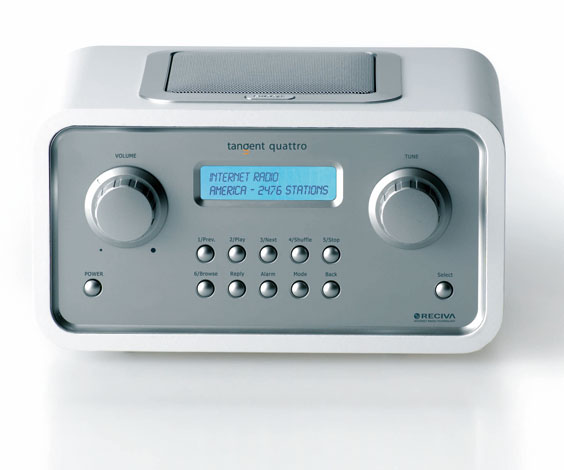Author: Lee Schlesinger
For an entertaining example of how Linux can power home appliances, check out the Tangent Quattro Internet radio. This device combines Internet and broadcast radio with a media server client on an embedded Linux platform to give you a variety of audio playback options.
 The Quattro has a solid feel. A single speaker at the top of the unit produces rich sound. The front panel has volume and tuning knobs and a dozen buttons for station presets and other functions. At the center of the front panel is a two-line LCD display that shows the station you’re listening to, menu choices, and status messages.
The Quattro has a solid feel. A single speaker at the top of the unit produces rich sound. The front panel has volume and tuning knobs and a dozen buttons for station presets and other functions. At the center of the front panel is a two-line LCD display that shows the station you’re listening to, menu choices, and status messages.
You can connect to the Internet via a built-in wireless Ethernet adapter that supports Wired Equivalent Privacy (WEP) and Wi-Fi Protected Access (WPA) encryption, or via an RJ-45 jack in the back of the unit. There you’ll also find aux-in, headphone, and line-out jacks, but no USB port into which you can plug a flash drive that contains music files to play.
The Quattro has a couple of ways you can get at the music. You can theoretically select an Internet station from the radio itself, but the process is virtually unworkable. You have to search a list of almost 12,000 stations by location or genre, or enter a search string by tediously moving the tuning knob to a letter and pressing Select, one letter at a time — but if you pause for more than five seconds while you consider the information on the LCD screen, the menu will disappear and you’ll have to work through the hierarchy again.
A better approach begins with creating an account at Reciva, a portal for Internet radio stations, to which Quattro connects when you power it up to get its list of stations — including any you associate with your unit. You can choose a few favorite stations on the site and save them as My Stations. Then go back to the radio, choose Select -> Stations -> My Stuff -> My Stations, and pick from among your list. To save a station you select, press and hold one of six numbered preset buttons on the front of the unit.
Preset stations are retained in the device’s memory even after it has been unplugged. However, the device takes several seconds to acquire a network connection every time you power it on.
When you turn it on, Quattro starts with the last station you were listening to, just like a regular radio. You can switch to a different station by pressing a preset button or using the tuning dial. But Quattro can do more than play Internet radio stations. If you press the Mode button once, the Quattro will play whatever you’re feeding through its aux in port. Pressing the Mode button twice lets you tune in FM broadcasts with a built-in retractable whip antenna, so you don’t have to waste preset slots on local stations — though you can assign a preset button to a broadcast station if you choose to. Press the Mode button a third time, and you go back to Internet stations.
An unusual and cool feature of the Quattro is its ability to stream files from any PC on the local network that’s acting as a media server by sharing music files. On my network, the Quattro saw a Samba share on an Ubuntu Hardy Heron box, and a shared directory on a Windows XP client. The first time it connects to a media server, the Quattro scans the specified folder for music tracks, which can take several minutes if you have a large collection, then writes a cache file in the directory to expedite future scans. The box can play music only in AAC, AIFF, AU, MP3, RM, WAV, and WMA formats. You can add tracks to the queue by album or by artist. Adding a lot of albums to your queue for random play can get tedious; luckily, Quattro also lets you specify an M3U playlist for all your tracks. You can also specify repeat and shuffle.
The Quattro includes a flexible alarm clock and five possible alarm time presets. The alarm can wake you with a buzzer or play any station the radio can receive. You can make an alarm go off on various schedules — once only, every day, weekdays, weekends, or weekly on a given day. At the other end of the day, a sleep timer function can turn the radio off after an interval you specify.
At $350 street price, the Quattro costs $150 more than another Linux-based Internet radio, the Com One Phoenix, which we reviewed earlier this year. The Quattro’s media server playback capabilities are absent in the Phoenix, and the Quattro’s audio has better sound, but the Phoenix lets you attach a USB drive and play any music files on it, and it offers two more preset buttons that the Quattro. I’d give the Phoenix an edge in value, but the Quattro leads in looks and audio aesthetics.
Categories:
- Reviews
- Hardware
- Entertainment


